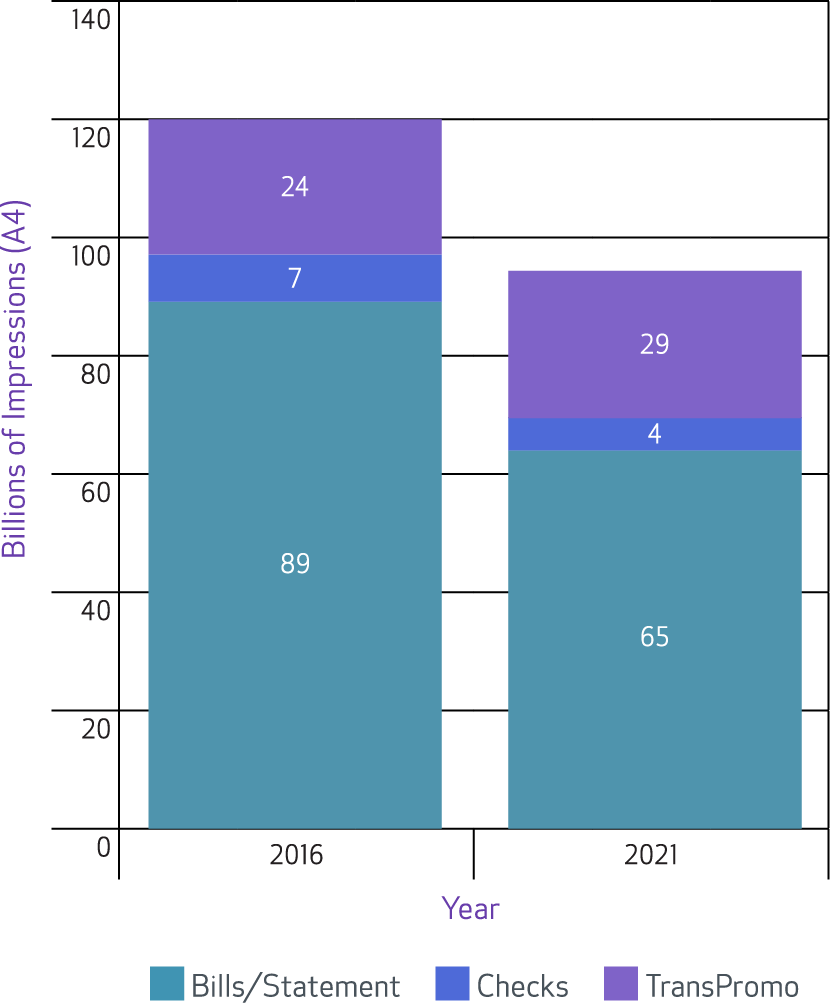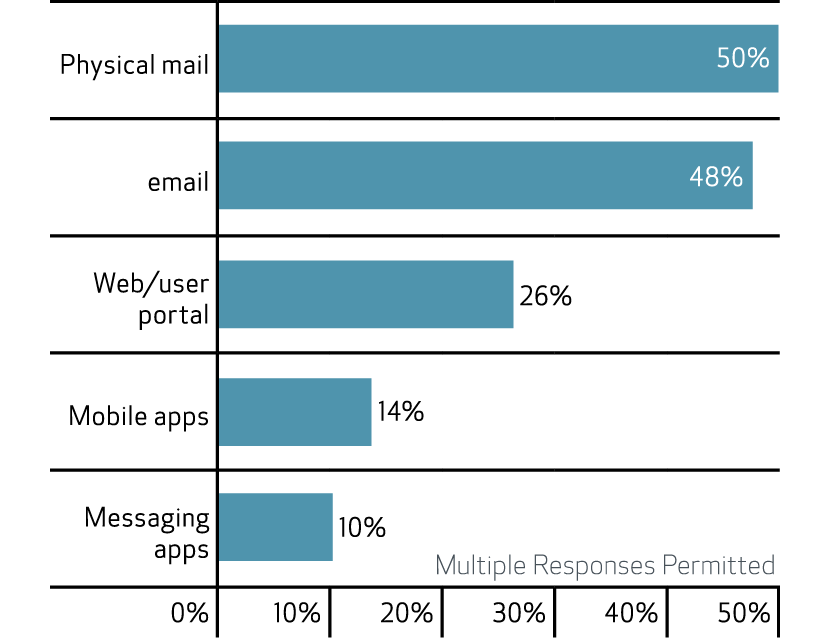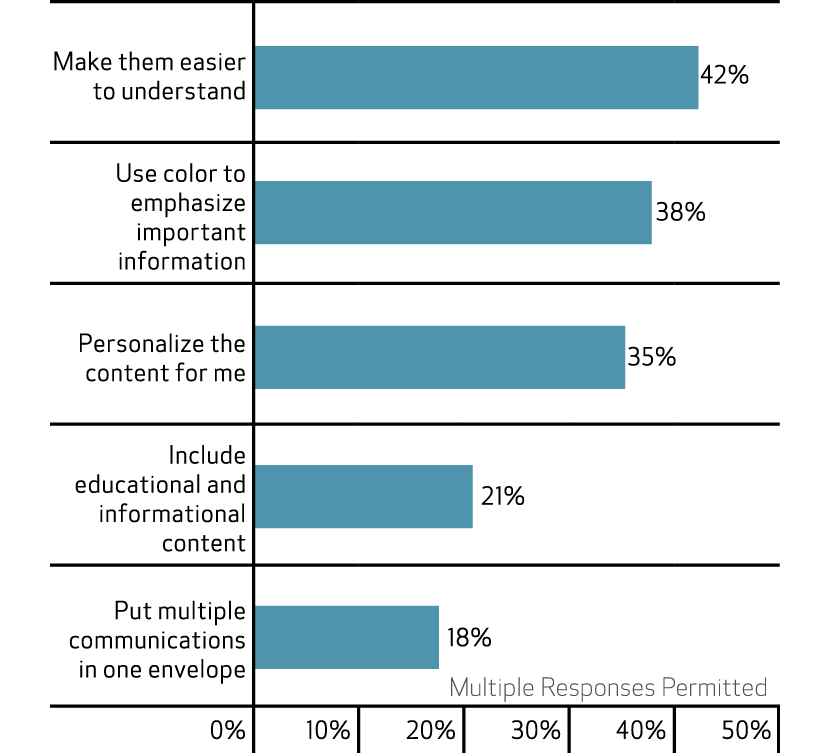Learn Why Innovation Should Be Your Priority in 2018
TRANSACTIONAL COMMUNICATIONS: 2018 BELONGS TO THOSE WHO INNOVATE AND EXECUTE!
Introduction
Transactional printing is the original variable data printing application. Each bill, statement, invoice, check, or explanation of benefits has content that is unique to the specific individual. In-plants and service bureaus alike need to be innovative with transaction documents, adding more value to make communications more meaningful to consumers. Service providers also need to invest in technology to make transactional communications more cost effective for enterprises. Many of today’s new and emerging business models incorporate expanded digital print technologies, data services, and omnichannel communications with intelligent workflow. Technological innovations will continue to transform the way your customers communicate in 2018, and service providers need to be at the forefront of innovation and execution for transactional printing.
Figure 1: Application Overview?— Transactional Documents

Source: U.S. Digital Production Printing Application Forecast: 2016–2021; InfoTrends 2017
Three Essential Components of Innovation
The year 2018 will require you to think about innovative ways to blend print with your customers’ drive toward digitization. There are three essential ingredients that will drive success with transactional communications:
1. Investing in the Right Technology
Technological investments must be made wisely and in the context of your organization’s overall business strategy. Printed transactional communications will primarily be driven by inkjet technology. According to the most recent application forecast from Keypoint Intelligence?—?InfoTrends, overall transactional printing volumes will decline from 120.4 billion impressions in 2016 to 97.4 billion impressions in 2021, demonstrating a compound annual growth rate (CAGR) of -4.8 percent. The area of opportunity lies in transpromotional printing, where marketers incorporate marketing messages into must-read documents like bills and statements. In the United States, digitally printed TransPromo pages are projected to surpass 29 billion in 2021, representing a CAGR of 3.5 percent.
TransPromo represents an opportunity for investors in inkjet technology during 2018. Inkjet devices enable print service providers to innovatively meet consumer demands for improved communications by blending transaction documents with color to increase comprehension. In addition, inkjet enables transaction documents to include personalized content, coupons, and premiums mapped to the individual consumer, as well as educational and informational content aligned with specific needs.
Service providers need to be at the forefront of innovation and execution for transactional printing.
2. Products and Services That Are Aligned to Customers’ Communication Preferences
Regardless of size or industry, all companies face the continual challenge of defining and developing products and services that customers want to buy. According to Anthony Ulwick, a pioneer of the Jobs-to-be-Done theory and inventor of Outcome-Driven Innovation® (ODI), “Only after knowing what jobs customers are trying to get done and what outcomes they are trying to achieve are companies able to systematically and predictably identify opportunities and create products and services that deliver significant new value. Only then can they figure out ‘what customers want.’” Successful service providers are building out innovative portfolios that meet current and future consumer expectations for transactional communications. In a world where all channels are “on,” leading service providers have taken the time to understand consumers’ communication preferences. An InfoTrends survey entitled Annual State of Transactional Communications surveyed 2,000 consumers in North America. Physical mail was the most commonly preferred channel, but service providers must prepare for a future where email, web portal communications, and mobile messaging apps will dominate customer requirements.
Figure 2: Through which channel would you prefer to receive legal notices, letters, and other business transactional communications from your providers? (Top Responses)

N = 2,000 Consumer Respondents in the U.S. and Canada
Source: Annual State of Transactional Communications Consumer Survey; InfoTrends 2017
Figure 3: How can your providers improve the business communications that they send to you in the mail? (Top Responses)

N = 2,000 Consumer Respondents in the U.S. and Canada
Source: Annual State of Transactional Communications Consumer Survey; InfoTrends 2017
Communications must also be data-driven. Today’s enterprises have more consumer information at their fingertips than ever before, and consumers expect these enterprises to use that data to deliver relevant and highly personalized transactional communications. When consumers were asked how providers could improve transactional communications, the key was ensuring that they were relevant to the recipient.
Offering services for enriching, analyzing, and segmenting data requires working closely with customers to understand their marketing strategy, customer targets, and product and service offerings. Providers that are offering these services are working with clients to understand the available data as well as additional data required. They are helping clients analyze and segment data into subsets that can be based on demographics (age, sex, ethnic background, etc.), use of specific products or services, psychographics (attitudinal cluster analysis), or needs. Transactional print service providers of all sizes are making an innovative move to add more data-related services as well as cross-channel support to add value to transactional communications.
3. It’s Time to Execute!
Coming up with ideas, or “ideating,” about new business models and opportunities is energizing as well as glamorous for many owners and executives. Ideation is the front end (or the beginning) of innovation, while implementation and execution are what convert innovative ideas into reality. Following through on plans is the behind-the-scenes dirty work. Even within the largest and most powerful businesses, big ideas won’t go anywhere if organizations don’t put the people, processes, and mechanisms in place to implement plans.
Chris Trimble and Vijay Govindarajan are innovation consultants and Distinguished Professors from the Tuck School of Business at Dartmouth College. Their bestselling business book entitled The Other Side of Innovation?—?Solving the Execution Challenge highlights five key steps in solving the innovation challenge:
Step 1: Acknowledge that the idea is just the beginning of the innovation process. True innovation requires discipline and the implementation of the right resources (technical, operations, and sales) for the hardest part?—?execution.
Print service providers will need to reinvent themselves in 2018.
Step 2: Commit! Owners must be committed to driving innovation, and they need to accept the fact that ongoing operations will not last forever.
Step 3: Redesign your organization for innovation. Printing firms are structured to support ongoing operations and are under pressure to deliver revenue and profits. Create an innovation team to focus on new market opportunities.
Step 4: The innovation team cannot be isolated, so a team leader must be appointed. The team leader needs to partner with ongoing operations and establish a relationship of mutual respect.
Step 5: The team needs to run a disciplined experiment to truly test the market opportunity. Business innovators must certainly leverage gut checks and emotion, but in the end, that art must be subjected to the discipline of the experiment.
Three Essential Components of Innovation
1
INVESTING IN THE RIGHT TECHNOLOGY
2
PRODUCTS AND SERVICES THAT ALIGN TO CUSTOMERS’ COMMUNICATION PREFERENCES
3
IT’S TIME TO EXECUTE!
2018 Belongs to Those Who Innovate and Execute!
Print service providers will need to reinvent themselves in 2018. They must come up with new ideas to keep operations, products, and services fresh and consistent with changing customer communications demands. Innovation isn’t just for large companies with enormous development budgets?—?small entrepreneurs can leverage their nimbleness to quickly drive new opportunities. Coming up with new ideas is important, but it’s only one step in the overall process. Today’s businesses have a much greater task in turning that idea into an actual product or service that will benefit customers during the execution stage. The winners of 2018 will be those who innovate and execute!
